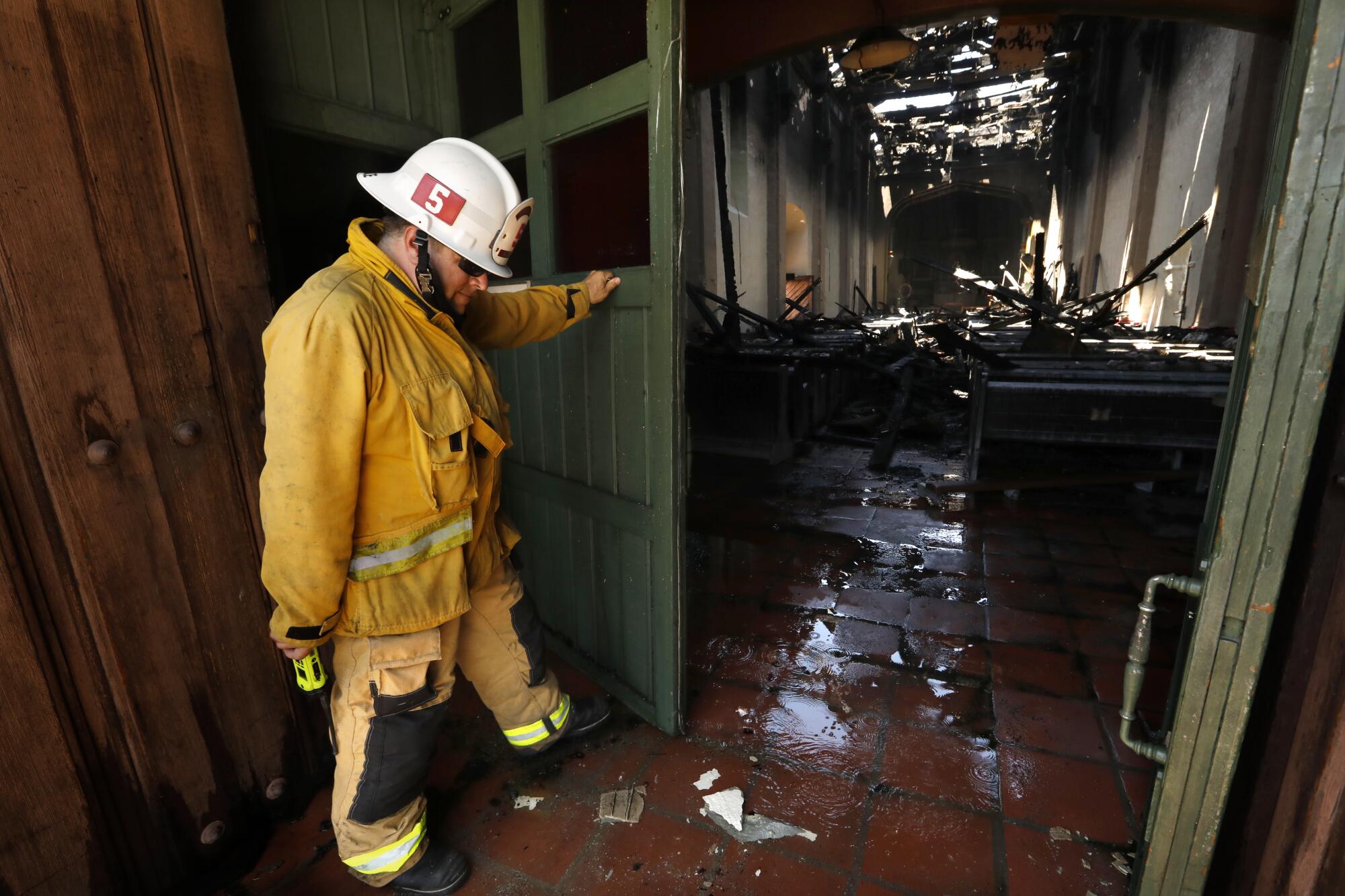
- Share via
It was a wake without a body as hundreds of parishioners from the San Gabriel Mission Roman Catholic community gathered Saturday in the parking lot to cry, grieve and pray after a fire tore through the historic landmark.
Flames destroyed the roof, most of the just-refurbished church pews and portions of the interior, though some statues and other historic items survived.
The blaze came amid a backlash against California missions and other colonial monuments that for many serve as painful reminders of the nation’s racist history. For that reason, investigators, including a representative from the federal Bureau of Alcohol, Tobacco, Firearms and Explosives, were looking into whether it was intentionally set, officials said.
“My heart is full of sadness,” said 70-year-old San Gabriel resident Anita Chavez, who calls herself a “lifetime parishioner.”
“This church has been at the center of my family, my world and my faith.”
Authorities received a call at 4:24 a.m. reporting that the mission’s fire alarm had been triggered, said Capt. Antonio Negrete, public information officer for the San Gabriel Fire Department. When an engine arrived to investigate, firefighters saw flames and smoke coming from the corner of the mission.
More units arrived on scene, and firefighters mounted an aggressive attack, fighting the flames from inside the church building. But after about 15 minutes, portions of the structure started to fall on them and they made the decision to exit and move to a defensive attack position, battling the fire from outside, Negrete said.
The fire was eventually raised to four alarms, drawing 50 firefighters from the San Gabriel Fire Department and other agencies. They were able to knock down the fire at 6:48 a.m. No injuries were reported, but the damage to the building was extensive.
“The roof of the mission is completely gone, and the interior up to the altar is completely destroyed,” Negrete said. The bell tower and museum remained intact, he said.
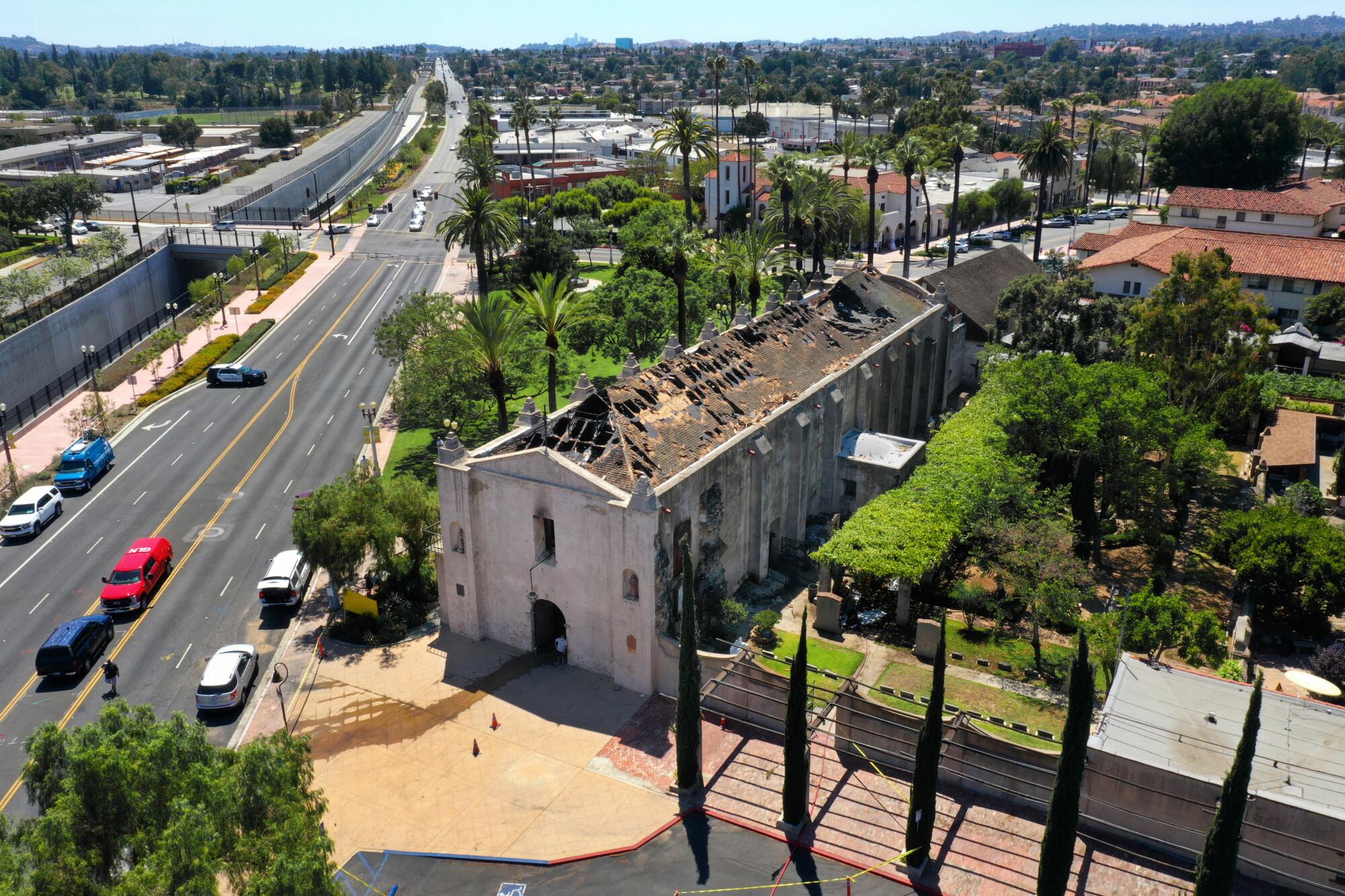
Still, most valuable artifacts escaped damage, said Terri Huerta, director of development and communications for the mission.
“The altar is still intact, the last time that we were able to take a peek inside,” she said. “It’s miraculously intact, including the historical wooden statues that were attached to the altar, and so we have a lot to be grateful for.”
A baptismal font consisting of a hammered copper basin and silver pieces donated by Spanish King Charles III in the late 18th century also survived, she said.
San Gabriel is considered to be one of the best-preserved missions, with the church building and altar dating to about 1805, Huerta said. The mission was first formed along the Rio Hondo in present-day Montebello and then moved to its current location in May 1775.
Along with the roof, the 107-year-old pews appeared to sustain the bulk of the damage, Huerta said. They had just been refurbished two weeks before, with the final ones installed Friday.
“It was a real labor of love to bring those pews back to life,” Huerta said. “They looked beautiful.”
Paint peeled from the walls, and it was possible that water from the firefighting efforts might have seeped into the adobe, which could cause problems, Huerta said. Still, she said, things could have been much worse.
“It’s a resilient old building and we are a resilient mission community,” she said. “We will find a way to rebuild and bring it back, absolutely.”
Los Angeles Archbishop José H. Gomez toured the fire damage around 10:25 a.m., while San Gabriel Valley regional Auxiliary Bishop David G. O’Connell met and spoke with distressed parishioners and visitors.
“We’re all brokenhearted by this, and this adds another trauma onto the present trauma of the coronavirus and everything else that’s happening,” O’Connell said. “People love the mission, and many of these families have connections going back generations.”
O’Connell mentioned Friday that mission staffers had “just … finished redoing the walls, getting them up to their original quality.” He was thankful that because of the refurbishment, some of the mission’s statues and artwork had been removed and thus spared from the blaze.
O’Connell said that despite Saturday’s fire, normal Sunday Mass will continue at the mission’s chapel, with social distancing and COVID-19 limits holding attendance to 100 people.
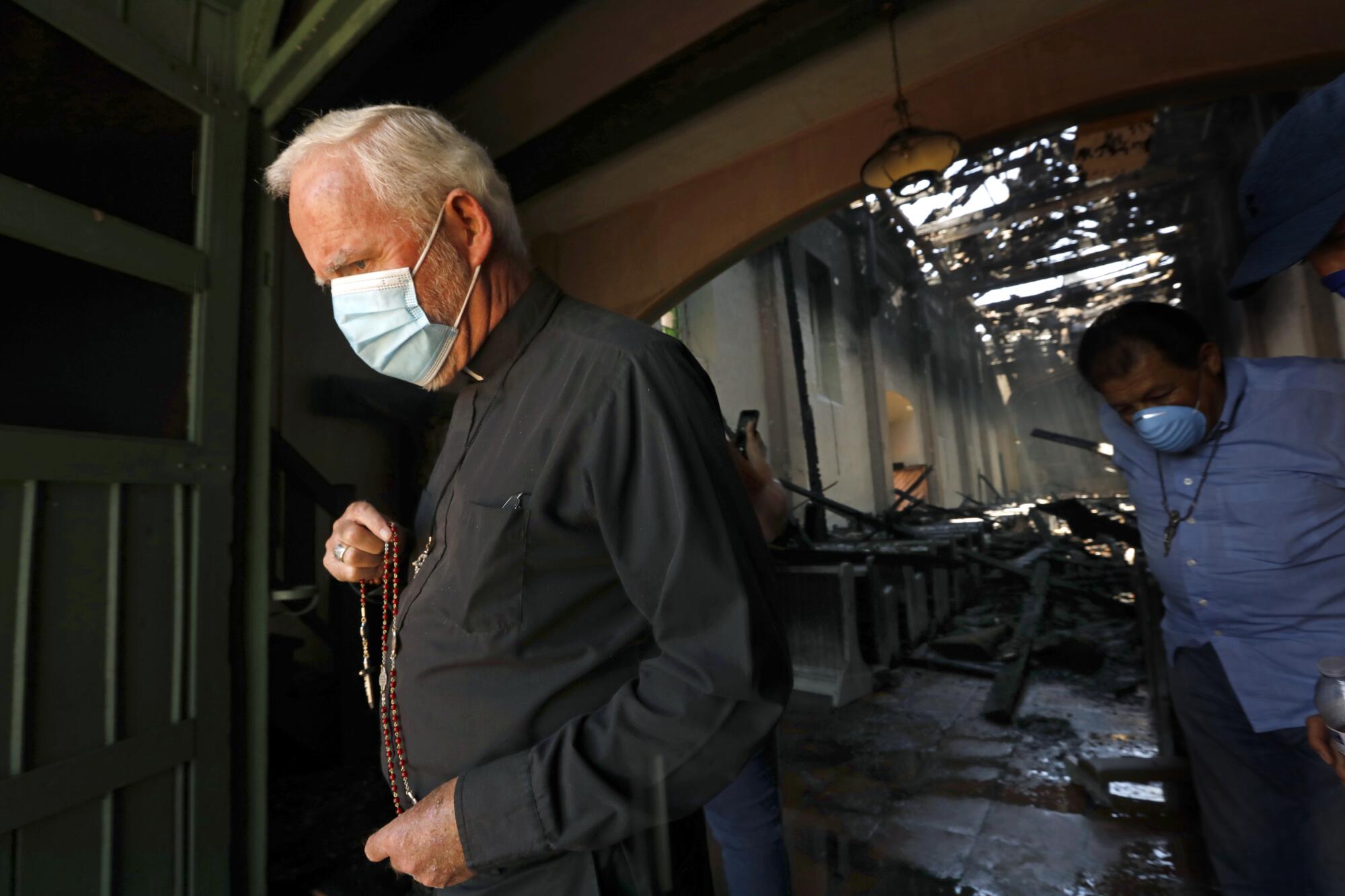
It took about seven hours for hot spots to cool down enough for investigators to be able to enter the church and begin their probe, Negrete said. Along with an ATF agent, they included a regional task force and a K-9 specially trained to detect accelerants, he said.
“Just because it’s a church, and I’m sure you’re aware of the recent vandalism that’s been done to the mission churches and the statues of Junipero Serra,” Negrete said. “So that’s part of the investigation.”
Founded by Franciscan Father Junipero Serra in 1771, the San Gabriel Mission has long been seen as an essential link to California’s past, as well as to the brutality and racism on which the state was founded.
Considered by historians to be the most important base of operations for the Spanish conquest of California, San Gabriel was the fourth of 21 missions established in the state, and one of the grandest. At its height in 1829, the mission had 50,000 livestock, 160,000 grapevines, and 2,300 fruit trees, said Philip Ethington, professor of history and political science and chair of the history department at USC.
But the church amassed those riches on the backs of the Tongva and other indigenous people, whom the friars forced into labor and coerced into converting to Catholicism and assimilating to their culture.
“It was really a labor camp enforced with whipping and stockades and lots of corporal punishment,” Ethington said.
Thousands are estimated to have died after they were exposed to foreign diseases or suffered other “comorbidities of conquest,” said William Deverell, director of the Huntington-USC Institute on California and the West and a professor of history at USC.
“It’s still a site of faith and worship, but it’s also a site of great sadness,” Deverell said. “Because in that parish ground, within the confines of the church, there are thousands of unnamed indigenous dead below what’s now a small Catholic cemetery.”
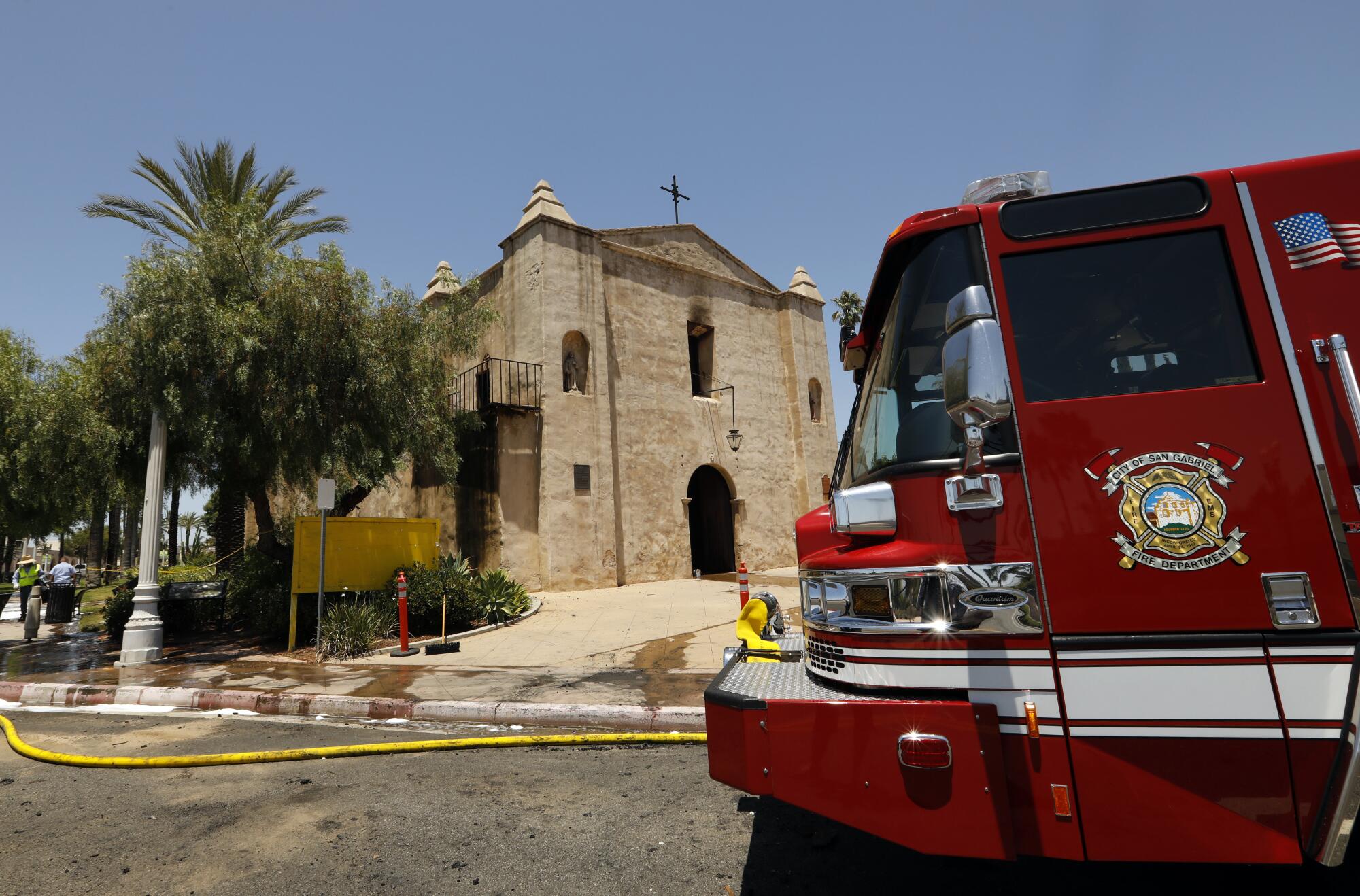
Yve Chavez, an assistant professor at UC Santa Cruz whose ancestors lived at the mission, helped build it and are buried in its cemetery, also described its legacy as complicated.
“On the one hand, the news of today is quite devastating because this is something that our ancestors made,” she said. “Some people might see these as monuments to Catholicism or Spain, but I think it’s important to recognize that this is the product of Native labor.”
Still, she noted, that work was performed under duress and came at an unspeakably high cost.
“The structure itself is a reminder of our ancestors who sacrificed their lives and their labor to make these missions possible,” she said.
Other experts shared similar assessments.
“The missions in California are definitely an integral part of California history, and from that standpoint I regret destruction however it did happen,” said Rick West, president and chief executive of the Autry Museum of the American West.
“The flip side of that is that … they’re very much an aspect of contested history because for Native peoples and Native communities, especially during the 18th and 19th centuries, the mission system does indeed represent a very unhappy chapter.”
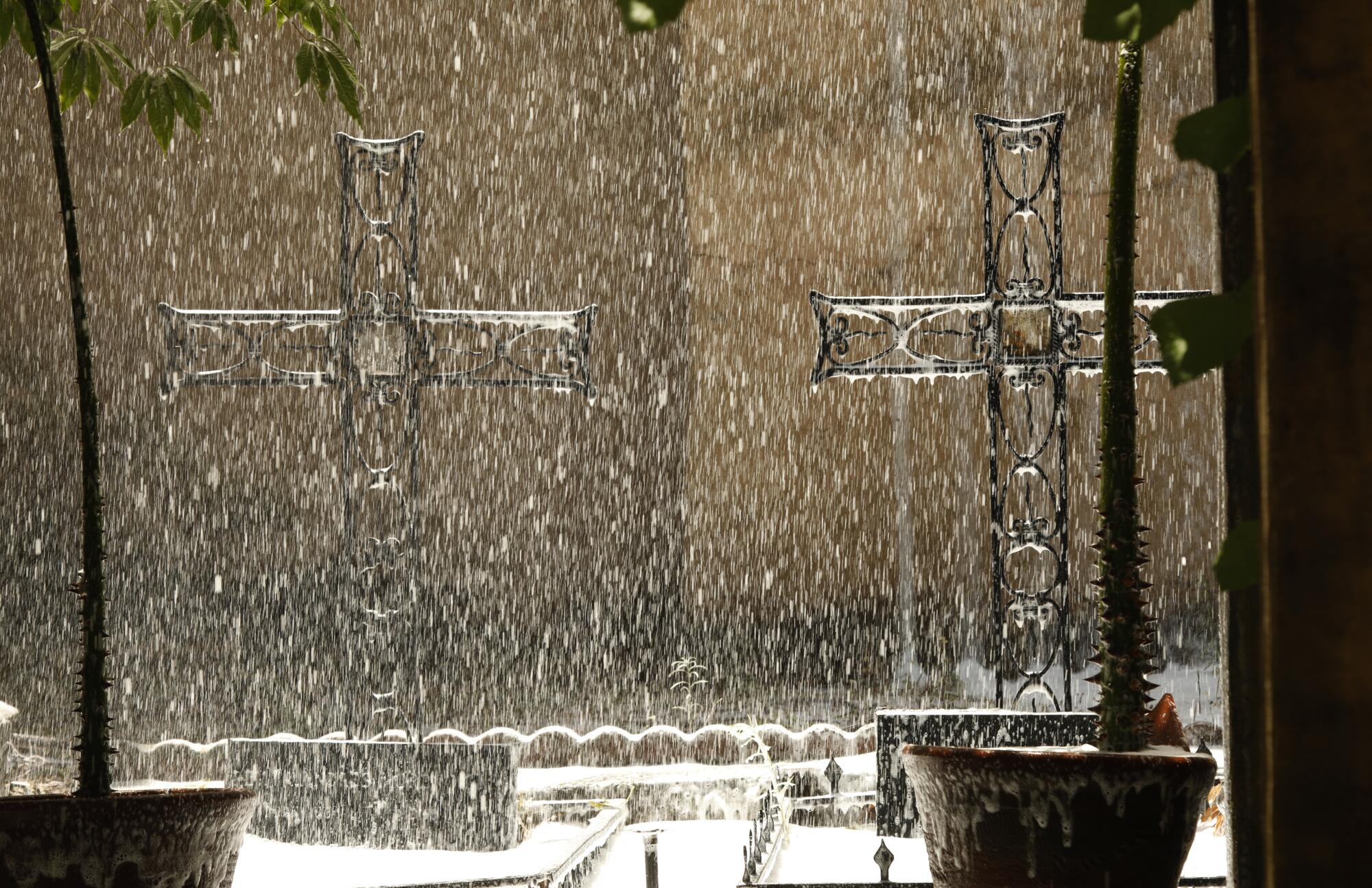
The San Gabriel Mission, owned by the Archdiocese of Los Angeles, will probably have the funding to be rebuilt and restored, he said. “I hope that an aspect of their rebirth will be this multiple voices approach, telling what happened in those spaces … and that storytelling is inclusive of Native voices.”
There are many ways to incorporate the history of the harm that was done to Native communities and include their voices today, West said.
“I would love to see missions reach out in their own storytelling to be inclusive of the breadth of the stories, including those stories that come out of the mouths of contemporary Native communities and people,” he said.
The San Gabriel Mission was already doing that work, said Julia Bogany, a member of the Tongva tribe and Tongva cultural officer for the San Gabriel Band of Mission Indians. She has worked with the mission for the last half-dozen years to bring more indigenous history into the space.
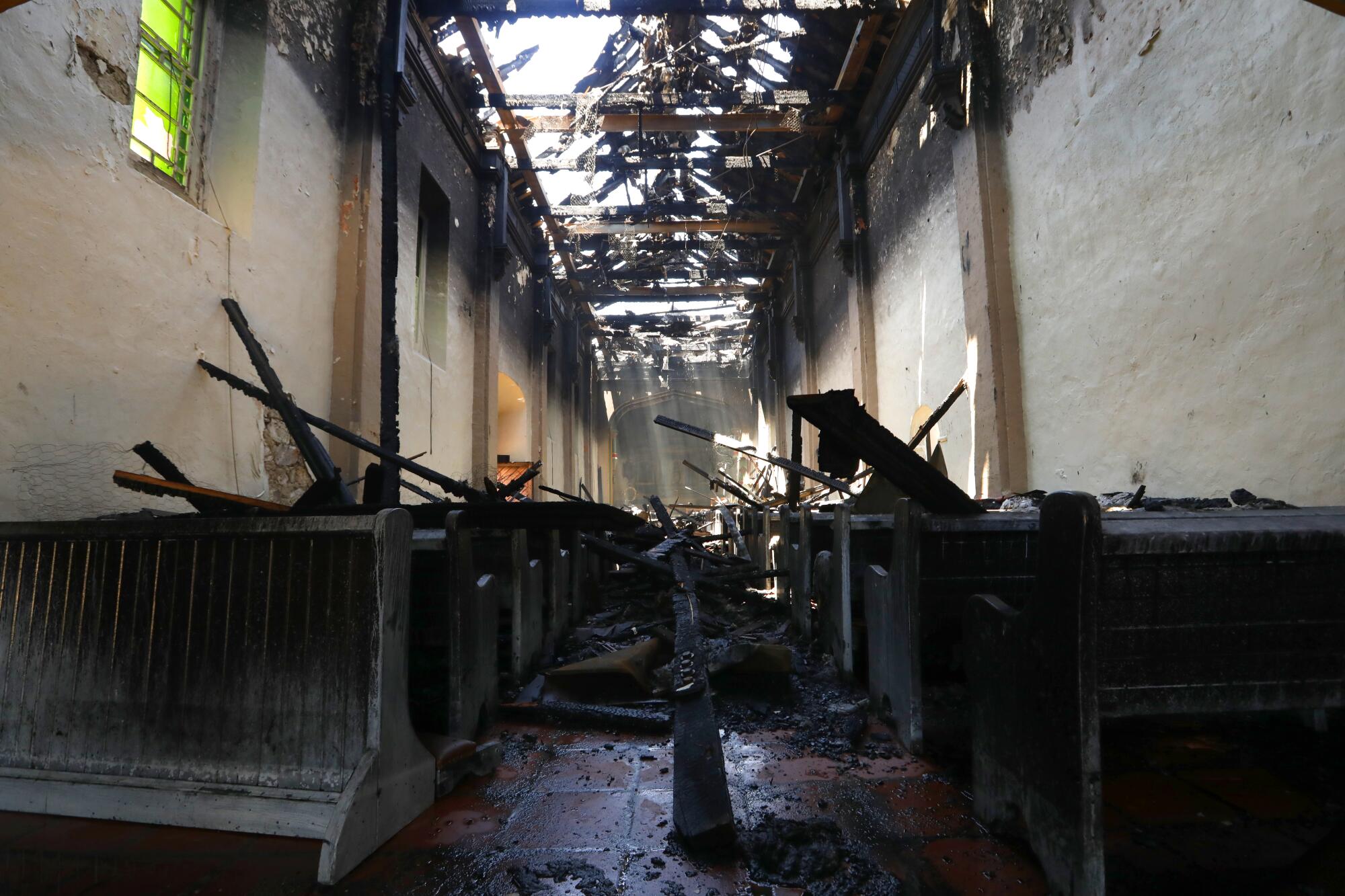
“I wanted to tell the truth so that our people can heal,” Bogany said, adding that people have to know their history in order to be able to heal from it, work she now does with younger generations.
She has held ceremonies at the mission, including one to release her ancestors’ spirits from the walls of the mission, and for years has taken children, college students and adults on tours in which she points out where and how her ancestors were mistreated and oppressed.
She convinced the church to include Tongva objects and culture in its museum. Now the mission sells her book in its store, and and this year she held storytelling events to describe the killing of Native American people across California during its history.
Bogany was sad when she saw images of the damaged mission Saturday morning, she said.
“A lot of work [went into] making that relationship that our tribe hasn’t been allowed to have … with the mission, that we can eat and laugh together regardless of whatever happened,” Bogany said. “I’ve been healed. They understand that, they understand the bad stories, but that’s a relationship between human beings and we can go on and make things better.”
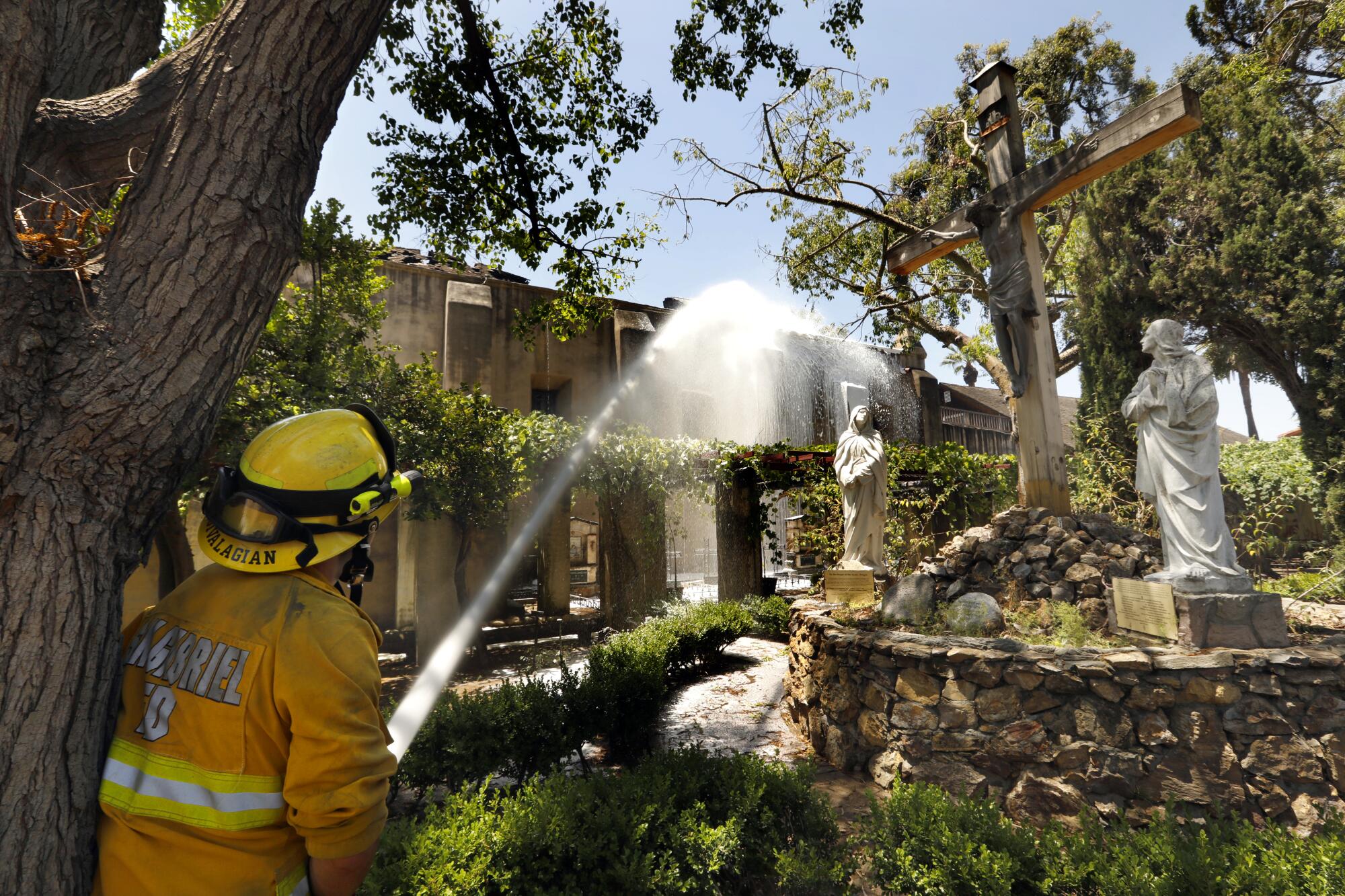
In addition to destroying the lives of Native Californians, the mission system has deeply tarnished the image of Serra, its architect, who has long been considered one of California’s founding fathers. Serra was made a saint by the Catholic Church in 2015, fueling outrage from many indigenous activists and others.
Statues of Serra have been targets of vandalism in recent years by activists who point to how the mission system enslaved and killed off Native Californians. Those protests grew in the wake of the police killing of George Floyd, which ignited a nationwide reckoning over racial justice. A Serra statue at Olvera Street was toppled, and officials in Ventura pledged to move a statue of Serra that stands outside City Hall.
The San Gabriel Mission also features a statue of Serra, and officials stepped up security around its grounds about two weeks ago, Huerta said.
“In light of what was happening in Ventura, we thought it prudent to alert the Police Department, and they put a decoy car in front of the statue as kind of a precaution, and they did extra patrolling,” she said.
About a week after that, the mission decided to move the statue into its garden, away from public view, Huerta said.
Authorities had not determined Saturday whether there was a possible link between the fire and the controversy surrounding the mission system and Serra’s legacy.
“It’s too early to tell whether there was any criminal activity,” Huerta said. “We will leave that up to the police and Fire Department and their investigation.”
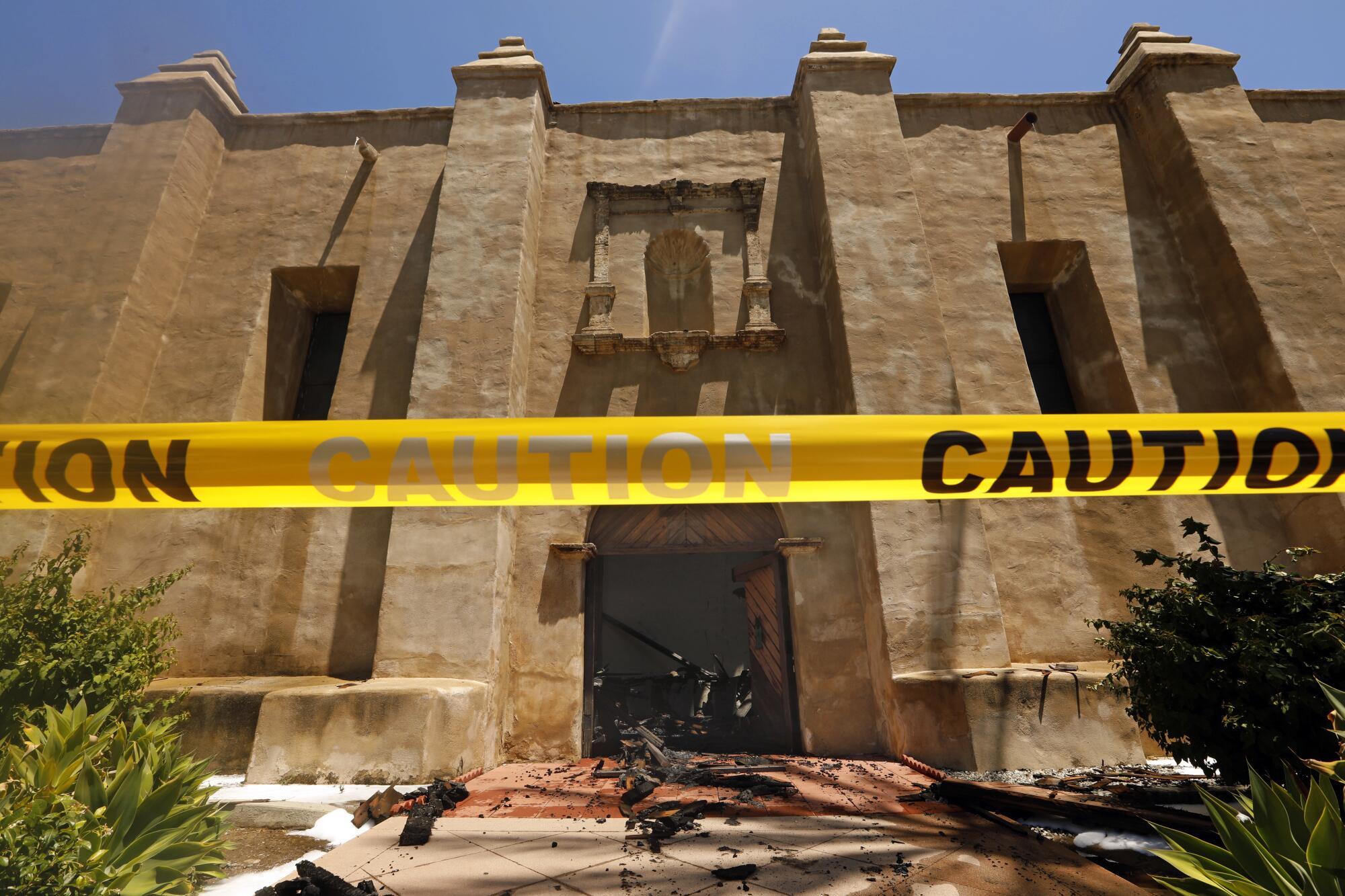
Previously, the mission was damaged after two powerful earthquakes in the late 1980s. The temblors showered the mission’s floor with mortar and caused religious statues, including a 200-year-old crucifix, to tumble to the floor.
Some other modifications were made to the church over the years, including adjusting the size of the windows and moving the bell tower, Huerta said.
“Through the years it stood as just a place of history and a place of tradition here in San Gabriel,” Huerta said. “So many people have been baptized here, married here, buried here. They have a real deep connection.”
Julie Sanchez Brehove has been going to the San Gabriel Mission all 27 years of her life. In November, she and her husband were married there. On Saturday morning at 9:30 a.m., they stood together from beyond the barrier set up by firefighters and watched their spiritual home smolder.
“For all of us parishioners, it’s our gathering place, it’s the center of our spiritual lives,” Sanchez Brehove said. She recognizes, though, that it has a history of harm.
“I understand that there is a lot of anger about the treatment of the indigenous people at the mission,” Sanchez Brehove said. “When I think of the mission, in my personal experience, it’s my gathering place and it’s a place where people are welcome, and we do try to live the way that Christ taught. But I do understand … that people in the history of the church have acted unjustly, and that’s something that can be very difficult to reconcile.”
She remembers always knowing that the land on which the mission stands belonged to the indigenous people first, and as a Catholic high school English teacher she discusses with her students the racist colonialist themes in 19th century literature, she said.
Thinking of her community today, Sanchez Brehove is grateful no one was hurt in this fire.
“We’ll probably still livestream Mass tomorrow, and we’re just praying for healing, praying for peace and praying and thanks-giving that no one was hurt.”
One of the more visible groups to arrive outside the church was a branch of the Knights on Bikes, a motorcycle group affiliated with the Knights of Columbus, a self-described fraternity of “Catholic men of faith and charitable action.”
Paul Padilla, 50, came from Fontana with a group of four other black-vested, blue-jeaned, masked members.
They assessed the situation, took photos, spoke with relatives and then pulled out rosaries and prayed.
“We saw the reports on TV and had to stop by,” Padilla said. “I grew up closer to the San Fernando Mission, but I had to come out and stand with the mission today and support my Catholic faith. This place is a part of our history.”
Fellow member David Sanchez, 59, grew up in East Los Angeles and remembered field trips as a young student to the mission, while Enrique Bonilla, 39, a Pasadena resident, said he had attended many mission services.
“It’s sad this happened,” Sanchez said. “This was a place of peace for so many people.”
More to Read
Sign up for Essential California
The most important California stories and recommendations in your inbox every morning.
You may occasionally receive promotional content from the Los Angeles Times.













